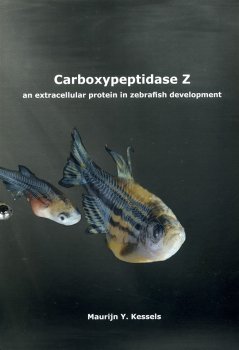category_thesis_subject
Carboxypeptidase Z an extracellular protein in zebrafish development
Historically the skeleton, in particular bone, was depicted as a rigid, inflexible, lifeless structure that readily breaks upon bending. We now know that bones in living organisms are complex, dynamic organs that combine toughness with flexibility. Astonishing is the fact that after their initial formation, bone structures are continuously remodeled (recycled and renewed), adapting to environmental demands at such a speed that in active healthy humans the distal part of the femur is completely replaced every six to twelve months. The zebrafish is a relatively new model organism in the field of skeletal development and primarily used as a powerful model for the identification of novel gene functions during skeletogenesis. At the molecular level, the biological similarity between zebrafish and humans is striking (Spoorendonk et al., 2010), but the actual skeletal composition of the zebrafish remained largely unknown.

The mechanical properties of the skeleton are largely dependent on the composition of proteins that are secreted into the extracellular matrix (ECM). In order to increase our understanding of normal skeletal development, it is necessary to identify and characterize changes in skeletal composition. The aim of this thesis was to analyze the composition of the extracellular matrix in zebrafish, in order to enable the identification of potential key regulatory proteins. By determination of the protein content in the zebrafish skeletal ECM with major changes in protein abundance during development we were able to identify various components of signaling pathways implicated in skeletogenesis. This first proteomic analysis of the zebrafish skeleton revealed the homology between the zebrafish and the skeleton of other vertebrate species including mammals. Our study provides a solid foundation for future studies on the composition and the regulation of the morphogenesis of the vertebrate skeleton.
After the identification of potential regulatory proteins in the developing zebrafish skeleton during the MS-based approach, the protein carboxypeptidase Z (Cpz) was selected for further analysis. This peptidase has previously been implicated in the Wnt signaling pathway, an elaborate pathway that regulates crucial aspects of development (Nusse and Varmus, 2012). Previous studies implicated a regulatory role for this peptidase through the processing of Wnt (Moeller et al., 2003; Wang et al., 2009). An analysis of the role of this peptidase in zebrafish was still lacking and therefore we mapped the spatio-temporal expression of cpz. We showed that expression of cpz is localized in and around juvenile zebrafish ossified structures. A more thorough analysis showed a complex expression pattern during early developmental stages that partially overlaps with that observed in other species. Furthermore, we provide a comparative view of cpz expression and the expression of its proposed ligand, Wnt4 (zebrafish Wnt4a and Wnt4b). Partial overlap with wnt4 expression provided the first evidence for a potential complementary function in the Wnt signaling pathway as observed in mammalian species.
In order to explore the role of cpz in zebrafish development, a loss-of-function mutant for zebrafish cpz was generated via TALEN-mediated mutagenesis. We show that mutant embryos display a variety of phenotypes during early development, most of which were similar to described defects in the Wnt/Calcium signaling pathway. These morphological phenotypes provide the first evidence for a connection between Cpz and regulation of the β-catenin independent Wnt signaling pathways which places the function of Cpz in a completely new perspective.
As a complement to these genetic studies an alternative approach was employed to examine the role of another pathway, the thyroid hormone system, in skeletogenesis. Thyroid hormones are required for skeletal development (Kim and Mohan, 2013), but to what extent thyroid hormone affects early bone development in zebrafish remained unclear. By exposing zebrafish embryos to the thyroid hormone triiodothyronine (T3) we showed that exposure accelerates ossification of craniofacial elements including the opercle and ceratohyal in a dose-dependent manner. This provides the first histological evidence of increased ossification in zebrafish due to thyroid hormone exposure which can be used as a starting point to explore the mechanism of thyroid hormone on skeletal development at a greater depth.
The zebrafish skeleton displays remarkable resemblance to that of other vertebrate species with regards to composition, regulatory components and hormonal response. The use of zebrafish as a model in future research will undoubtedly increase our understanding of vertebrate skeletal development and disease. In this thesis we provide a first insight in the extracellular protein content of the zebrafish skeleton, identify a role for the Cpz protein in β-catenin independent (non-canonical) Wnt signaling during development and shows the effect of thyroid hormone on ossification during early zebrafish development.